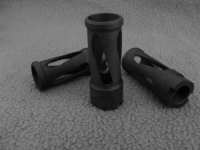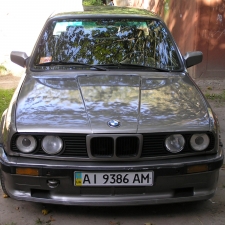FLASH HIDER

This flash hider was designed with preservation of the night vision of the shooter as the number one priority.
Night blinding from muzzle flash is very detrimental in combat situations due to the long periods between follow up shots. To reduce this effect the following things were designed into this unit.
It has bi-directional ports cut around the perimeter to assist in the leaning of the air/fuel mixture that is required for combustion. It also has a tapered bore to help slow the escaping gas so it has more time to mix with the additional air to further reduce the air/fuel mixture even more.
The small grooves cut around the perimeter of the ports are anti-resonance grooves that help reduce barrel vibrations, thereby stabilizing the bullet sooner in it’s flight. It is cut down for fitment of rifle grenades or a bayonet. It is 2.240″ in length so as to bring a 14.5″ rifle up to legal length with correct attachment techniques.
The muzzle is “banded” to give it strength, stabilize rifle grenades, and to provide a snag-free muzzle for tactical situations requiring speed and mobility.
The air / fuel ratio that supports combustion is 14.7 to 1 respectively The region we are trying to stay out of is between the LEL and the UEL limits. We can not add more fuel to make the ratio too rich so we are mainly concerned with the LEL (Lower Explosive Level). This is the point where combustion is possible, below this point and the mixture is too lean to burn. By adding more air to the mixture (something that IS available) we can lean it to the point that it will not burn. The bullet passes through the inner chamber and pulls a slight vacuum behind it, this pulls in extra air that mixes with the exiting gases thereby leaning the mixture inside the flash hider. This also cools the hot escaping gases as well, lowering the temp to a point that reduces the ability for the gases to ignite outside of the barrel. The leaned and slightly cooler air/fuel mixture then escapes through the forward end of the four ports and out the front of the unit.
Link to parts manufacturerThis flash hider was designed with preservation of the night vision of the shooter as the number one priority.
Night blinding from muzzle flash is very detrimental in combat situations due to the long periods between follow up shots. To reduce this effect the following things were designed into this unit.
It has bi-directional ports cut around the perimeter to assist in the leaning of the air/fuel mixture that is required for combustion. It also has a tapered bore to help slow the escaping gas so it has more time to mix with the additional air to further reduce the air/fuel mixture even more.
The small grooves cut around the perimeter of the ports are anti-resonance grooves that help reduce barrel vibrations, thereby stabilizing the bullet sooner in it’s flight. It is cut down for fitment of rifle grenades or a bayonet. It is 2.240″ in length so as to bring a 14.5″ rifle up to legal length with correct attachment techniques.
The muzzle is “banded” to give it strength, stabilize rifle grenades, and to provide a snag-free muzzle for tactical situations requiring speed and mobility.
The air / fuel ratio that supports combustion is 14.7 to 1 respectively The region we are trying to stay out of is between the LEL and the UEL limits. We can not add more fuel to make the ratio too rich so we are mainly concerned with the LEL (Lower Explosive Level). This is the point where combustion is possible, below this point and the mixture is too lean to burn. By adding more air to the mixture (something that IS available) we can lean it to the point that it will not burn. The bullet passes through the inner chamber and pulls a slight vacuum behind it, this pulls in extra air that mixes with the exiting gases thereby leaning the mixture inside the flash hider. This also cools the hot escaping gases as well, lowering the temp to a point that reduces the ability for the gases to ignite outside of the barrel. The leaned and slightly cooler air/fuel mixture then escapes through the forward end of the four ports and out the front of the unit.
*

comments